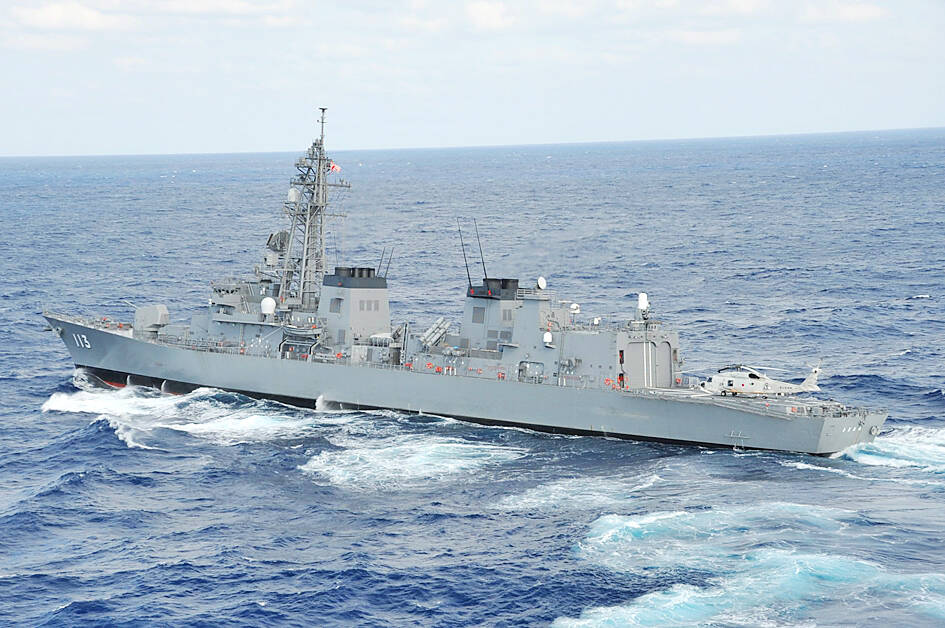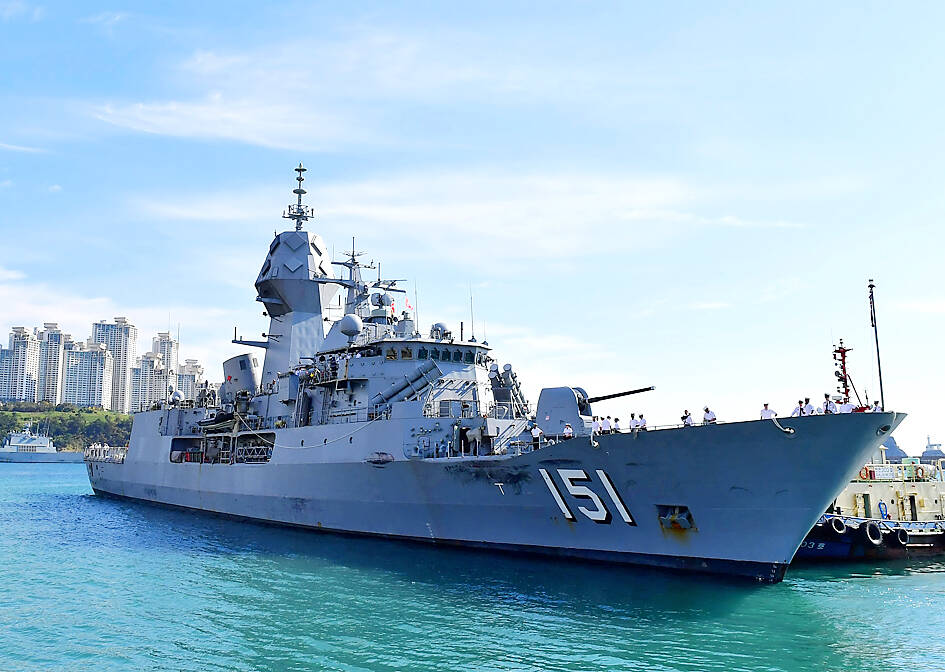The Japan Maritime Self-Defense Force on Wednesday made its first-ever transit through the Taiwan Strait in response to the intrusion by a Chinese reconnaissance aircraft into Japan’s sovereign airspace last month, Yomiuri Shimbun reported yesterday.
The Japanese news platform reported that the destroyer JS Sazanamisailed down through the Taiwan Strait on Wednesday, citing sources in the Japanese government with knowledge of the matter.
Japanese Chief Cabinet Secretary Yoshimasa Hayashi declined to comment on the reports at a regular briefing because they concern military operations.

Photo courtesy of the Japanese Ministry of Defense
Military vessels from New Zealand and Australia also sailed through the Strait on the same day, Wellington’s defense ministry said yesterday.
One of its ships, the HMNZS Aotearoa, made its first passage through the Taiwan Strait in seven years, alongside the Australian guided missile destroyer HMAS Sydney to assert the “right of freedom of navigation,” a defense source said.
The official added that the mission was not conducted with Japan.

Photo: EPA-EFE
The three nations were scheduled to engage in a joint military exercise in the South China Sea yesterday, Japanese media reported.
Japanese Prime Minister Fumio Kishida ordered the transit as a response to the incursion last month by a Chinese People’s Liberation Army (PLA) Y-9 reconnaissance aircraft into Japanese airspace after consulting with his Cabinet, the report said.
The Chinese aircraft entered Japan’s airspace at 11:29am on Aug. 26 from east of the Danjo Islands and left the area at 11:31am.
On Wednesday last week, the Chinese aircraft carrier Liaoning and two other PLA ships entered Japan’s contiguous zone while sailing through the area between Japan-governed Yonaguni Island and Iriomote Island.
Bec Strating, professor of international relations at La Trobe University, said Japan’s reported Taiwan Strait transit “is part of a broader pattern of greater naval presence by countries in and beyond Asia that are concerned about China’s maritime assertions.”
“Japan in particular has been dealing with China’s ‘gray zone’ tactics in the East China Sea,” including an increasing number of coast guard vessels sailing close to disputed islands in the region, she said.
The US and Canada have sailed through the Taiwan Strait numerous times before.
On Sept. 13, a German frigate and a supply ship sailed through the Taiwan Strait en route to Jakarta, marking the first such transit in 22 years.
It was followed on Tuesday last week by the passage of a US P-8A Poseidon maritime patrol aircraft through the Strait.
The next day, China’s Liaoning aircraft carrier sailed through the waters northeast of Taiwan, followed by the incursion on Monday of a Russian Il-38 patrol aircraft near Japan’s Hokkaido.
Additional reporting by Aaron Tu

TRAGEDY STRIKES TAIPEI: The suspect died after falling off a building after he threw smoke grenades into Taipei Main Station and went on a killing spree in Zhongshan A 27-year-old suspect allegedly threw smoke grenades in Taipei Main Station and then proceeded to Zhongshan MRT Station in a random killing spree that resulted in the death of the suspect and two other civilians, and seven injured, including one in critical condition, as of press time last night. The suspect, identified as a man surnamed Chang Wen (張文), allegedly began the attack at Taipei Main Station, the Taipei Fire Department said, adding that it received a report at 5:24pm that smoke grenades had been thrown in the station. One man in his 50s was rushed to hospital after a cardiac arrest

A car bomb killed a senior Russian general in southern Moscow yesterday morning, the latest high-profile army figure to be blown up in a blast that came just hours after Russian and Ukrainian delegates held separate talks in Miami on a plan to end the war. Kyiv has not commented on the incident, but Russian investigators said they were probing whether the blast was “linked” to “Ukrainian special forces.” The attack was similar to other assassinations of generals and pro-war figures that have either been claimed, or are widely believed to have been orchestrated, by Ukraine. Russian Lieutenant General Fanil Sarvarov, 56, head

SAFETY FIRST: Double the number of police were deployed at the Taipei Marathon, while other cities released plans to bolster public event safety Authorities across Taiwan have stepped up security measures ahead of Christmas and New Year events, following a knife and smoke bomb attack in Taipei on Friday that left four people dead and 11 injured. In a bid to prevent potential copycat incidents, police deployments have been expanded for large gatherings, transport hubs, and other crowded public spaces, according to official statements from police and city authorities. Taipei Mayor Chiang Wan-an (蔣萬安) said the city has “comprehensively raised security readiness” in crowded areas, increased police deployments with armed officers, and intensified patrols during weekends and nighttime hours. For large-scale events, security checkpoints and explosives

PUBLIC SAFETY: The premier said that security would be tightened in transport hubs, while President Lai commended the public for their bravery The government is to deploy more police, including rapid response units, in crowded public areas to ensure a swift response to any threats, President William Lai (賴清德) said yesterday after a knife attack killed three people and injured 11 in Taipei the previous day. Lai made the remarks following a briefing by the National Police Agency on the progress of the investigation, saying that the attack underscored the importance of cooperation in public security between the central and local governments. The attack unfolded in the early evening on Friday around Taipei Main Station’s M7 exit and later near the Taipei MRT’s Zhongshan